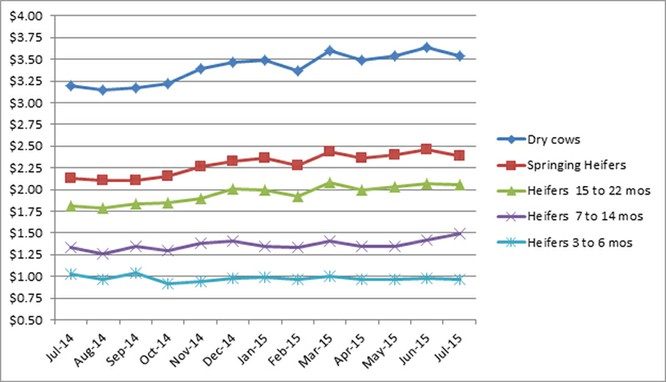Making Sense of Feed Efficiency

There has been a lot of press recently about genetic selection for production efficiency. Research in this area has far reaching implications with climate change, nutrient management and economics. However, how can feed efficiency (FE) be used on the farm right now?
Production perspective
There has been a lot of press recently about genetic selection for production efficiency. There was a symposium focused on this topic at the 2015 American Dairy Science Association meeting held in Orlando Florida. This research has far reaching implications with climate change, nutrient management and economics. However, how can feed efficiency (FE) or dry matter intake efficiency be used on the farm right now?
For lactating dairy cows FE equals energy corrected milk divided by dry matter intake. The most difficult number to obtain in this equation is dry matter intake. As important a number as this is, it is still very elusive on many dairy operations. For herds that have the luxury of grouping cows based on certain criteria, FE can help determine if the ration is on target. If it is being done on a whole herd basis, this can be a useful number to check monthly over time to make sure the herd is on track based on days in milk.
Feed efficiency is similar to income over feed costs (IOFC), checking the number once at a point in time is not very meaningful. The value of these numbers comes when evaluating them over time. Monitoring FE monthly can give insights into how cows are utilizing energy from the ration. Income over feed costs can provide information on if feed costs are in line with animal production. A general recommendation for FE for a one group total mixed ration is 1.40 - 1.60.
In the Penn State dairy herd FE and IOFC were monitored monthly. The table below shows how FE and IOFC compare to other herd metrics for 2009 through 2013. The mature cows' average body weight was approximately 1450 pounds. When examining the five year average for FE, the months of May and January consistently had the highest FE at 1.44 and the months of September and October had the lowest at 1.36. The other months were very consistent at 1.40 (data not shown). The low efficiencies during September and October reflected animals trying to rebound from the summer heat. Also starting in August was usually when there were a large number of animals freshening and they typically have lower FE (1.30-1.60).
Using FE and IOFC together as a tool can be very effective in detecting if there are missed opportunities for improving animal performance or profitability. Both are relatively easy to calculate and monitor over time, however, they should never be the only information used when making decisions. They are adequate at illustrating if there are potential problems and if further investigation is warranted.
Action plan for sampling forages
Goal: Monitor feed efficiency and income over feed costs on a monthly basis to evaluate animal performance.
Steps
- Step 1: Test dry matters weekly on all high moisture ingredients and adjust rations accordingly. Record the percent dry matter of the ration(s) fed.
- Step 2: Daily, record batch weights fed to all lactating cow pens and the number of cows in each pen. Include refusals to determine actual feed amounts consumed.
- Step 3: Calculate dry matter intake for each pen and determine the average for the herd accounting for cow numbers in each group and their respective intakes.
- Step 4: Monthly, record average milk production, milk fat% and milk protein %. Using the equation [(12.82 x fat lbs) (7.13 x protein lbs) (0.323 x milk lbs.)]/DMI, determine FE.
- Step 5: Using the DairyCentsPRO mobile app, calculate IOFC.
- Step 6: Meet with the appropriate people on a scheduled basis to review the information and make decisions based on the results. Record the date of any changes made to evaluate the impact on FE and IOFC.
Economic perspective
Monitoring must include an economic component to determine if a management strategy is working or not. For the lactating cows income over feed costs is a good way to check that feed costs are in line for the level of milk production. Starting with July 2014 milk price, income over feed costs was calculated using average intake and production for the past few years from the Penn State dairy herd. The ration contained 63% forage consisting of corn silage, haylage and hay. The concentrate portion included corn grain, candy meal, sugar, canola meal, roasted soybeans, Optigen and a mineral vitamin mix. All market prices were used.
Also included are the feed costs for dry cows, springing heifers, pregnant heifers and growing heifers. The rations reflect what has been fed to these animal groups at the Penn State dairy herd. All market prices were used.
Income over feed cost using standardized rations and production data from the Penn State dairy herd.
Note: July's PSU milk price: $16.93/cwt; feed cost/cow: $6.32; average milk production: 81 lbs.
Feed cost/non-lactating animal/day.

Source: Penn State Extension








